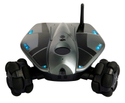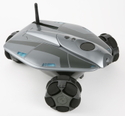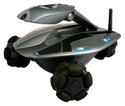Mobile robot packs web-cam, runs eCos
Last updated Sep 16, 2008 — 6596 views Get ready for Rovio, a small three-wheeled mobile robot that offers audio/visual telepresence via its built-in wireless web-cam. An onboard webserver enables access from anywhere in the world, according to WowWee, which plans to ship the product soon.
Get ready for Rovio, a small three-wheeled mobile robot that offers audio/visual telepresence via its built-in wireless web-cam. An onboard webserver enables access from anywhere in the world, according to WowWee, which plans to ship the product soon.
Rovio includes a head-mounted, 640 x 480 pixel video camera for capturing video and still shots of what it sees. The camera is mounted on an extensible arm, which can be positioned at three elevations — foot-level; waste-level, head-level — to afford various views of the environment. An LED headlight can be switched on to improve visibility in dimly-lit environments.


WowWee’s Rovio mobile robot has a built-in webserver
(Click each image to enlarge)
As the mobile robot moves about, it transmits video and audio over its WiFi interface in real time. Rovio’s three-wheeled base provides omnidirectional mobility; it’s also used for panning the video camera.
The device can be accessed over a local WiFi network via a PC, Mac, or other wirelessly-networked device. A user-defined ID with password guards against unauthorized access.
Users can also access their Rovio from anywhere in the world, without a PC being turned on in the device’s local environment, the company says. This capability is enabled by an embedded webserver, according to WowWee. Additionally Rovio can email images to a designated address.
DeviceGuru asked WowWee how Rovio would be accessed from out there in the cloud. The answer lies in the use of Dynamic DNS services, such as that of DynDNS. “Rovio has a client for several Dynamic DNS services built into it,” a spokesman replied by email. “Similar to a router, a user only has to create a free account and fill in the account details on the Rovio. Then Rovio will automatically connect to the internet and update it’s IP and the user can put what ever URL they want in there. www.steve.mydomain.com, for example.”
Rovio keeps track of its location using a GPS-like “TrueTrack” positioning system. This function is based on IR (infrared) technology: the device has an onboard IR sensor; multiple “Room Beacons” must be placed in each room of the local environment; Rovio’s battery-recharging docking station is also equipped with a Beacon. The Beacons shine their signals toward the ceiling, and Rovio continually scans the ceiling looking for its “north star,” a WowWee spokesperson explained.
Rovio’s onboard rechargeable batteries work for about two hours, according to the company. The device periodically recharges itself automatically by “self-docking” with its charging station, which it locates using the TrueTrack positioning system.
The following short video, provided by WowWee, demonstrates what Rovio can do and how it is used:
Rovio demonstration video
(Click image to play video)
According to WowWee, Rovio comes with easy-to-install PC software that automatically detects computer settings and assists with set-up of the device. Additionally, available video plug-ins let users access their Rovio using Skype or Windows Live Messenger (MSN). The company also says it provides step-by-step setup instructions for wirelessly mating Rovio with Macs and generic handheld devices using ad-hoc WiFi connections.
DeviceGuru learned that Rovio’s embedded intelligence is powered by an unspecified ARM9 RISC processor running the open source eCos OS on 8MB RAM and 2MB flash. Beyond that, we managed to cobble together the following list of specs and features:
- Processor — ARM9 processor, clocked at around 200MHz
- Memory — 8MB RAM; 2MB flash
- Operating system — eCos, an open-source embedded RTOS
- Locomotion — three wheels
- Video camera — wide-angle view; 640 x 480 pixels resolution; unspecified frame rate
- Video streams in MPEG4 format
- Connectivity — WiFi and USB
- Security — user-defined login and password
- Wireless positioning system — comprises IR (infrared) beacons on Rovio, charging dock, and in each room
- Built-in speaker and microphone
- Power — rechargeable NiMH battery pack; 2 hours operation per charge
A WowWee spokesman emphasized that hardware specs, such as processor, memory, power consumption, etc., may change in future models (which are currently being developed).
According to WowWee, Rovio will soon be available for about $300 at “major retailers nationwide,” and currently can be pre-ordered online at Hammacher, here and at Amazon, here. TrueTrack Room Beacons will be sold separately. Further information will eventually be available here.

